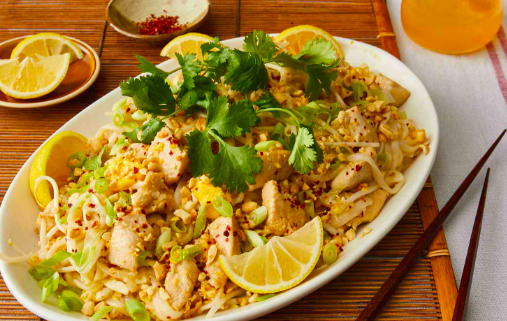Introduction: Pad Thai, a quintessential Thai dish, is a harmonious blend of flavors and textures that captures the essence of Thai cuisine. This iconic street food has transcended its origins and become a global sensation, adored by food enthusiasts worldwide. Let’s embark on a flavorful journey to uncover the secrets behind the beloved Pad Thai.
Origins and History: Pad Thai’s roots can be traced back to the 1930s in Thailand. As urbanization transformed the country, the Thai government aimed to promote a sense of national identity. Pad Thai emerged as a result of these efforts, blending Chinese and Thai culinary influences to create a dish that resonated with the evolving Thai palate.
Ingredients: The beauty of Pad Thai lies in its simplicity and the artful combination of key ingredients. Rice noodles, commonly used in Thai cuisine, form the dish’s base. Shrimp, tofu, or chicken are often added for protein, while a medley of fresh bean sprouts, green onions, peanuts, and lime wedges provide a delightful crunch and brightness.
Tamarind Sauce – The Heart of Pad Thai: What sets Pad Thai apart is the sweet, sour, and savory tamarind-based sauce that envelops the noodles. Tamarind lends a distinct tanginess, balancing the sweetness of palm sugar and the umami of fish sauce. This symphony of flavors creates a sauce that coats each strand of noodle, delivering a burst of taste with every bite.
The Cooking Process: Pad Thai is known for its quick and dynamic cooking process, often performed in a wok over high heat. The noodles are stir-fried with the chosen protein, eggs, and the signature tamarind sauce. The addition of bean sprouts, green onions, and peanuts follows, infusing the dish with layers of textures and flavors.
Garnishes and Presentation: A Pad Thai dish is incomplete without a final flourish of fresh herbs, such as cilantro and Thai basil. Lime wedges are served on the side, allowing diners to customize the dish according to their taste preferences. The vibrant colors and aromatic herbs not only enhance the visual appeal but also contribute to the overall sensory experience.
Global Popularity: In recent decades, Pad Thai has transcended its humble origins to become a symbol of Thai culinary prowess. Renowned for its balance of sweet, sour, salty, and spicy notes, Pad Thai has captured the hearts and taste buds of people worldwide. Its adaptability to various dietary preferences, with vegetarian and vegan versions readily available, has contributed to its widespread popularity.
Conclusion: Pad Thai is not just a dish; it’s a celebration of Thai culinary artistry. As you savor the distinctive flavors of Pad Thai, you embark on a journey through time, exploring the roots of Thai cuisine and the cultural fusion that brought this dish to life. Whether enjoyed on the bustling streets of Bangkok or at a local Thai restaurant, Pad Thai continues to be a testament to the rich tapestry of global gastronomy.
